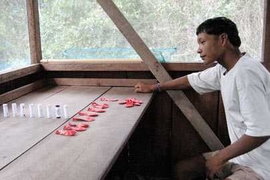American children learn the meanings of number words gradually: First they understand “one,” then they add “two, “three,” and “four,” in sequence. At that point, however, a dramatic shift in understanding takes place, and children grasp the meanings of not only “five” and “six,” but all of the number words they know.
Scientists have also seen this pattern in children raised speaking other languages, including Japanese and Russian. In all of these industrialized nations, number learning begins around age 2, and children fully understand numbers and counting by the age of 4 or 5.
A new study from cognitive scientists at MIT and the University of Rochester finds the same developmental trajectory in children from a farming and foraging society in the Bolivian rainforest. But there, it occurs much later — beginning around age 5, and finishing around age 8.
The findings suggest that number learning is a fundamental process that follows a universal pathway, says Edward Gibson, a professor of brain and cognitive sciences at MIT. However, the timing of the process depends on a child’s environment — specifically, how much exposure he or she has to numbers and counting.
“We were interested in exploring this in a language culture where numbers are not really a dominant component of that culture,” Gibson says. “It appears they do go through exactly the same stages of learning number words, it’s just way later.”
Gibson is the senior author of a paper describing the findings in the journal Developmental Science. The paper’s lead author is former MIT graduate student Steven Piantadosi, now an assistant professor at Rochester. Julian Jara-Ettinger, an MIT graduate student, also contributed to the paper.
Less exposure to numbers
In the United States, most parents start teaching their children numbers as soon as they are able to talk. However, that is not true of the Tsimane’, a society of about 13,000 people in the Amazon River basin, nor do Tsimane’ children have exposure to toys or television shows that emphasize number learning. “Numbers are just not a big deal in their culture,” Gibson says.
Most Tsimane’ children start going to school around age 5, but education levels among adults vary widely, from zero to 12 years of schooling. Although the Tsimane’ live in a fairly remote area, they do have some contact with Spanish speakers living nearby. The Tsimane’ language has words for numbers up to 15, but their words for numbers larger than that are borrowed from Spanish, Piantadosi says.
During a 2012 trip to Bolivia, the researchers tested the counting ability of 92 Tsimane’ children by giving each child eight pennies, then asking the children to hand them a certain number of pennies.
Based on each child’s success rate with numbers one through eight, the researchers could classify them into different stages of number learning. Children were classified as knowing how to count if they performed perfectly or made only one mistake. Most of the remaining children fell into groups that knew only the number one, the numbers one and two, the numbers one through three, and a few that knew one through four — the same breakdown seen in children in industrialized countries.
The results suggest that those counting stages are universal in child development, the researchers say.
“It easily could have been the case that stages that you see in U.S. kids are just some artifact of education or ‘Sesame Street’ or how parents talk to their kids here,” Piantadosi says. “The more exciting possibility is that those stages are really fundamental to learning numbers. There’s something about trying to acquire that conceptual linguistic system that pushes you through those different stages of knowledge.”
The only difference seen in the Tsimane’ children was that counting abilities developed much later. The researchers found true counting ability in Tsimane’ children ranging from ages 5 to 11, but most 5- and 6-year-olds, as well as some children as old as 8, had not yet learned it.
The findings suggest that these stages of number-learning are a necessary part of the process of building number concepts, says Barbara Sarnecka, an associate professor of cognitive sciences at the University of California at Irvine who was not part of the research team.
“Basically, everyone seems to follow the same path to number knowledge, whether they are a preschooler in a highly industrialized, numerate society or a 12-year-old in a farming and foraging society in Bolivia. That tells us a lot about how number concepts are built in the mind,” she says.
“Data-driven development”
Last year, Piantadosi, Josh Tenenbaum, a professor of brain and cognitive sciences, and former MIT postdoc Noah Goodman developed a computational model of how this number-learning process could work.
The model takes as its input a number word, such as “two,” and contextual information, such as how many objects are present when the word “two” is heard. The model accumulates evidence and tries out different algorithms for counting objects and assigning a number to a set of objects. Those algorithms build on simple operations that can be performed on sets of objects, such as removing one object or combining two sets.
“It turns out the naturalistic data that parents would provide to kids should be enough to figure out how counting works without having to build in a lot of innate knowledge about counting,” Piantadosi says. “You can construct a counting algorithm out of simpler set operations.”
This suggests that data input is critical to learning to count, Piantadosi says. “Our explanation of what’s going on with the Tsimane’ kids is that it just takes them longer to get data. They go through the exact same stages, but it takes them two or three times as long to get an equivalent amount of data as a U.S. kid,” he says. “It’s a data-driven developmental process.”
If they obtain permission from the Tsimane’, the researchers are interested in studying whether educational strategies such as teaching preschool Tsimane’ children to recite the numbers one through 10, as American parents often do with their young children, would enable them to learn to count earlier.
The research was funded by the National Science Foundation and the National Institutes of Health.










